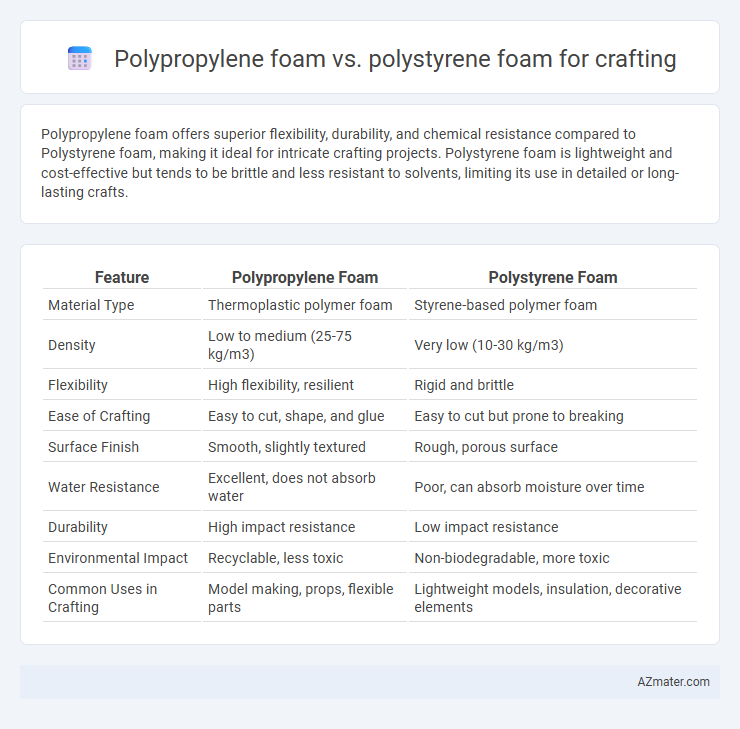Polypropylene foam offers superior flexibility, durability, and chemical resistance compared to Polystyrene foam, making it ideal for intricate crafting projects. Polystyrene foam is lightweight and cost-effective but tends to be brittle and less resistant to solvents, limiting its use in detailed or long-lasting crafts.
Table of Comparison
| Feature | Polypropylene Foam | Polystyrene Foam |
|---|---|---|
| Material Type | Thermoplastic polymer foam | Styrene-based polymer foam |
| Density | Low to medium (25-75 kg/m3) | Very low (10-30 kg/m3) |
| Flexibility | High flexibility, resilient | Rigid and brittle |
| Ease of Crafting | Easy to cut, shape, and glue | Easy to cut but prone to breaking |
| Surface Finish | Smooth, slightly textured | Rough, porous surface |
| Water Resistance | Excellent, does not absorb water | Poor, can absorb moisture over time |
| Durability | High impact resistance | Low impact resistance |
| Environmental Impact | Recyclable, less toxic | Non-biodegradable, more toxic |
| Common Uses in Crafting | Model making, props, flexible parts | Lightweight models, insulation, decorative elements |
Introduction to Polypropylene and Polystyrene Foams
Polypropylene foam features a lightweight, closed-cell structure offering superior flexibility, durability, and resistance to chemicals compared to polystyrene foam, which is rigid, brittle, and more prone to cracking. Polystyrene foam, widely used in crafting for its ease of cutting and shaping, lacks the impact resistance that polypropylene foam provides, making it less suitable for projects requiring durability. Both foams exhibit excellent insulation properties, but polypropylene foam's enhanced resilience makes it a preferred choice for long-lasting craft applications.
Material Properties Comparison: Polypropylene vs Polystyrene
Polypropylene foam offers superior flexibility, impact resistance, and chemical durability compared to polystyrene foam, making it ideal for intricate and reusable craft projects. Polystyrene foam is lightweight and rigid with excellent insulation properties but is more brittle and prone to cracking under stress. Both materials provide varying densities and textures, but polypropylene's resilience and moisture resistance enhance longevity and versatility in crafting applications.
Durability and Flexibility in Crafting Applications
Polypropylene foam offers superior durability compared to polystyrene foam, resisting dents, cracks, and moisture, making it ideal for long-lasting crafting projects. Its higher flexibility allows intricate shaping and bending without breaking, unlike polystyrene foam which is rigid and prone to chipping. For applications requiring impact resistance and customizable forms, polypropylene foam provides enhanced performance and reliability.
Ease of Cutting, Shaping, and Assembly
Polypropylene foam offers superior ease of cutting and shaping due to its flexible yet resilient structure, allowing for precise, clean cuts with standard craft tools. Polystyrene foam, while lightweight and rigid, tends to crumble or produce uneven edges when cut, requiring specialized blades or hot-wire cutters for smooth shaping. Assembly with polypropylene foam is often more reliable as it bonds well with various adhesives without deteriorating, whereas polystyrene foam may dissolve or weaken when exposed to certain glues or solvents.
Safety and Toxicity: Crafter Considerations
Polypropylene foam offers lower toxicity and better chemical resistance compared to polystyrene foam, making it a safer choice for crafting projects involving prolonged skin contact or indoor use. Polystyrene foam can release styrene vapors, which pose health risks such as respiratory irritation and potential carcinogenic effects, especially during cutting or heating processes. Crafters should prioritize polypropylene foam to minimize exposure to harmful emissions and ensure a safer crafting environment.
Texture and Finish: Visual and Tactile Differences
Polypropylene foam offers a smoother texture and a more uniform finish, making it ideal for detailed crafting projects requiring precision and clean edges. Polystyrene foam, characterized by its slightly rougher and more porous surface, provides a lightweight yet less refined tactile experience, often resulting in visible bead patterns. The visual crispness of polypropylene contrasts with the matte, slightly granular appearance of polystyrene, influencing both aesthetic appeal and finishing techniques in craft applications.
Adhesion and Paint Compatibility
Polypropylene foam offers superior adhesion properties compared to polystyrene foam, making it ideal for bonding with various glues commonly used in crafting. Unlike polystyrene foam, polypropylene has a smoother, less porous surface that can better retain paint, resulting in more vibrant and durable finishes. Paint compatibility on polypropylene is enhanced by using acrylic or water-based paints, while polystyrene foam often requires specialized primers to prevent paint from dissolving the material.
Weight, Density, and Project Suitability
Polypropylene foam is lighter and has a lower density, around 30-60 kg/m3, making it ideal for lightweight craft projects that require flexibility and durability. Polystyrene foam, with a higher density range of 14-40 kg/m3, offers rigid structure and ease of shaping, suited for detailed models and architectural crafts. Polypropylene's resilience and resistance to moisture make it better for outdoor or handled pieces, whereas polystyrene's stiffness favors static displays and precision work.
Cost Analysis for Hobbyists and Professionals
Polypropylene foam generally offers better durability and resistance to chemicals, making it a preferred choice for professional crafters despite its higher initial cost compared to polystyrene foam. Polystyrene foam is more affordable and widely available, ideal for hobbyists requiring lightweight materials for temporary or decorative projects. Cost analysis reveals that while polypropylene foam incurs a steeper upfront investment, its longevity and reusability can reduce long-term expenses for high-frequency or complex crafting tasks.
Eco-Friendly Aspects and Recycling Options
Polypropylene foam offers superior eco-friendly benefits compared to polystyrene foam due to its higher recyclability and lower environmental impact during production. While polystyrene foam is notorious for its persistence in landfills and limited recycling facilities, polypropylene foam can be recycled into durable products, reducing waste accumulation. Choosing polypropylene foam for crafting projects supports sustainable practices by minimizing non-biodegradable waste and promoting circular economy principles.

Infographic: Polypropylene foam vs Polystyrene foam for Crafting
 azmater.com
azmater.com